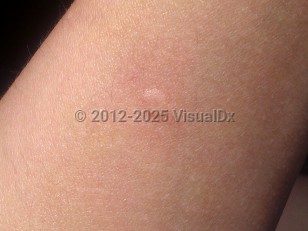Wasp or yellow jacket sting in Adult
Alerts and Notices
Important News & Links
Synopsis

Wasps are a diverse group of insects with worldwide distribution that includes any insect of the order Hymenoptera, suborder Apocrita, that is not a bee or ant. However, the term wasp is often used in a narrower sense to just describe members of the Vespidae family, which include the medically important hornets (Vespa species), yellow jackets (Vespula and Dolichovespula species), and paper wasps (Polistes species). Vespidae wasps look similar to bees but are less hairy and have thin waists (except the yellow jackets). Yellow jackets are typically black and yellow in color, although a few are black and white, including the large black-faced hornet (Dolichovespula maculata), which is misnamed a hornet.
Wasps are social insects, living in colonies, and they build paper nests, which they will fiercely defend. Yellow jackets build nests underground (Vespula) or aboveground in trees or buildings (Dolichovespula).
Wasp stings are the most common human envenomation. The stings from all species are similar, but hypersensitivity reactions may be quite specific. Wasps (including yellow jackets) can sting repeatedly, especially when trapped in clothing, because their stingers do not have barbs, like some bees.
Wasp venom is similar to bee venom, but the venoms are generally not cross-reactive. Wasp venom contains enzymes, small peptides, and amines. The allergens include the phospholipases, hyaluronidases, and cholinesterases. Some peptides cause histamine release by degranulating mast cells. Histamine, serotonin, and acetylcholine contribute to the pain associated with wasp stings.
Local wasp sting reactions include immediate pain, swelling, and redness at the sting site that often subsides within a few hours.
Regional reactions (exaggerated local reactions) occur in some individuals with extended swelling that can last 2-7 days. These reactions are not allergic in origin.
Anaphylactic reactions cause diffuse urticaria, pruritus, angioedema, bronchoconstriction, respiratory distress, hypotension, loss of consciousness, and cardiac arrhythmias. Typically, onset of life-threatening, anaphylactic signs will occur within 10 minutes of the sting.
Acute myocardial infarction, hepatitis, intravascular hemolysis, rhabdomyolysis, acute renal failure, and glomerulonephritis following a wasp sting have been rarely reported.
Wasps are social insects, living in colonies, and they build paper nests, which they will fiercely defend. Yellow jackets build nests underground (Vespula) or aboveground in trees or buildings (Dolichovespula).
Wasp stings are the most common human envenomation. The stings from all species are similar, but hypersensitivity reactions may be quite specific. Wasps (including yellow jackets) can sting repeatedly, especially when trapped in clothing, because their stingers do not have barbs, like some bees.
Wasp venom is similar to bee venom, but the venoms are generally not cross-reactive. Wasp venom contains enzymes, small peptides, and amines. The allergens include the phospholipases, hyaluronidases, and cholinesterases. Some peptides cause histamine release by degranulating mast cells. Histamine, serotonin, and acetylcholine contribute to the pain associated with wasp stings.
Local wasp sting reactions include immediate pain, swelling, and redness at the sting site that often subsides within a few hours.
Regional reactions (exaggerated local reactions) occur in some individuals with extended swelling that can last 2-7 days. These reactions are not allergic in origin.
Anaphylactic reactions cause diffuse urticaria, pruritus, angioedema, bronchoconstriction, respiratory distress, hypotension, loss of consciousness, and cardiac arrhythmias. Typically, onset of life-threatening, anaphylactic signs will occur within 10 minutes of the sting.
Acute myocardial infarction, hepatitis, intravascular hemolysis, rhabdomyolysis, acute renal failure, and glomerulonephritis following a wasp sting have been rarely reported.
Codes
ICD10CM:
T63.461A – Toxic effect of venom of wasps, accidental, initial encounter
SNOMEDCT:
241819002 – Wasp sting
T63.461A – Toxic effect of venom of wasps, accidental, initial encounter
SNOMEDCT:
241819002 – Wasp sting
Look For
Subscription Required
Diagnostic Pearls
Subscription Required
Differential Diagnosis & Pitfalls

To perform a comparison, select diagnoses from the classic differential
Subscription Required
Best Tests
Subscription Required
Management Pearls
Subscription Required
Therapy
Subscription Required
References
Subscription Required
Last Updated:03/22/2018
 Patient Information for Wasp or yellow jacket sting in Adult
Patient Information for Wasp or yellow jacket sting in Adult
Premium Feature
VisualDx Patient Handouts
Available in the Elite package
- Improve treatment compliance
- Reduce after-hours questions
- Increase patient engagement and satisfaction
- Written in clear, easy-to-understand language. No confusing jargon.
- Available in English and Spanish
- Print out or email directly to your patient
Upgrade Today

Wasp or yellow jacket sting in Adult

